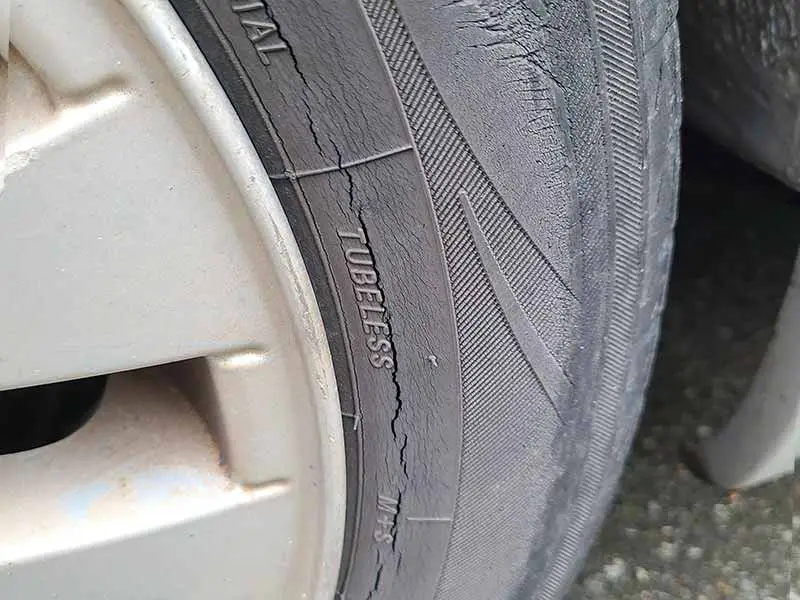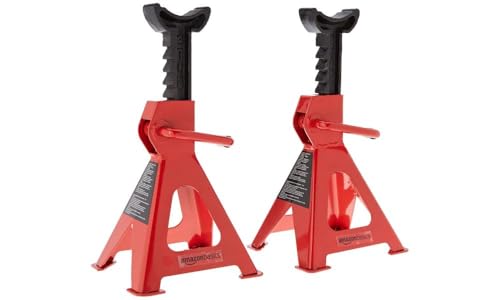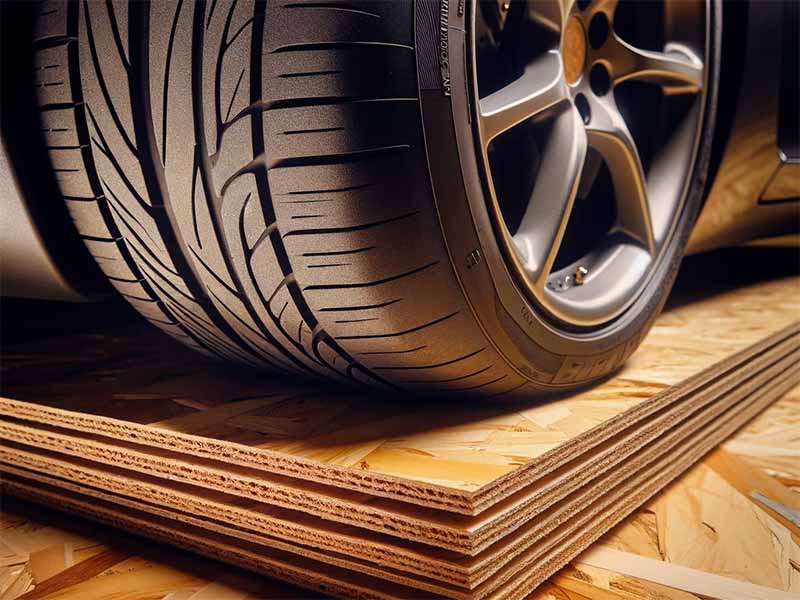Ever wonder why some people place wood under their tires when parking for a long time? Whether it’s for the winter chill or a long break from driving, the way you store your car can significantly impact its longevity and performance.
Putting Wood Under Tires For Storage
Placing wood under tires for storage, especially plywood, helps distribute the vehicle’s weight evenly, helps prevent tire deformation, and offers protection from moisture and temperature fluctuations.
In this article, we’ll explore various methods for tire storage, delve into the science behind tire preservation, and provide practical advice on how to best protect your tires during prolonged periods of inactivity.

Tire Cradles
Common Methods for Tire Storage
When it comes to storing your car, whether for the chill of winter or a long vacation, where you leave your tires can make a world of difference. Let’s dive into the common methods folks use, and see how they stack up.
Parking on Plywood
- The Go-To Method: Many car enthusiasts swear by plywood. It’s about giving your tires a firm, flat surface that distributes weight evenly. Here’s why it’s popular:
- Even Weight Distribution: Plywood prevents the tires from developing flat spots by distributing the car’s weight more evenly.
- Moisture Resistance: It acts as a barrier between your tire and damp surfaces, especially in areas like a garage floor.
Carpet Under Tires During Winter Storage
- Soft Landing: Some prefer the cushioning effect of carpet remnants. Here’s the breakdown:
- Insulation: Carpet acts as an insulator against cold garage floors, which is a plus in freezing conditions.
- Convenience: Often it’s about recycling what you have at home. However, its effectiveness compared to more robust methods is worth a closer look.
Storing Cars on Concrete Floors
- The Old Debate: Parking directly on concrete has been a topic of heated debate. Let’s clear the air:
- Concrete’s Downside: It’s hard and unyielding, which can lead to flat spots over time. Plus, moisture from concrete can affect the tire rubber.
- Modern Tires: Today’s tires are more resilient, but long-term, you’re better off giving them a bit of cushion and moisture protection.
Tire Cradles
- Cradle Your Rubber: Tire cradles are shaped to the tire’s natural curvature, aiming to preserve their shape and integrity. Here’s the scoop:
- Shape Preservation: They help prevent flat spots and maintain the tire’s shape, crucial for long storage periods.
- Cost vs. Benefit: While effective, they are an investment. For the casual storager, simpler methods might be more cost-effective.

The Science of Tire Storage
So, we’ve looked at the common methods, but let’s get a bit more into the nitty-gritty of why tire storage matters. It’s not just about keeping your car off the street; it’s about preserving your tires’ integrity, shape, and performance. Here’s the science behind tire storage.
Temperature Fluctuations
- The Big Chill: Tires don’t like extreme temperatures. Cold can make them brittle, and heat can accelerate aging. Here’s how it breaks down:
- Cold Weather: As temperatures drop, tires can harden and become less flexible, increasing the risk of damage.
- Hot Weather: Heat can exacerbate tire aging, increasing the risk of cracks and wear.
Moisture and Its Effects
- Wet Woes: Moisture is a tire’s silent enemy, lurking in your garage or storage area. It’s all about:
- Rubber Deterioration: Prolonged exposure to moisture can deteriorate rubber, reducing tire life.
- Corrosion: For steel-belted tires, moisture can lead to rusting of the internal steel components.
Pressure Points and Tire Deformation
- The Weighty Issue: Tires are designed to be round, not flat. When a car sits in one place too long:
- Flat Spots: The weight of the car pressing down can cause flat spots, especially in colder temperatures.
- Long-Term Damage: These flat spots can become permanent, leading to a bumpy ride or even requiring tire replacement.
Clarifying Myths vs. Facts
- Concrete Concerns: The belief that concrete destroys tires is widespread, but let’s add some context:
- Old vs. New Tires: Older tires were more susceptible to moisture and concrete’s hardness. Today’s tires are more durable, but prolonged contact with concrete isn’t ideal.
- Barrier Benefits: Regardless of tire age, a barrier like plywood can provide beneficial insulation and pressure distribution.

Why Wood? An In-depth Look
Alright, we’ve explored various methods, but let’s zero in on why wood, especially plywood, often takes the crown for the best tire storage solution. It’s not just about tradition; it’s about science and practicality. Here’s what makes wood the go-to choice for many.
Insulating Properties
- Barrier Between Tire and Ground: Wood, particularly plywood, provides an excellent insulative barrier between your tire and the cold or damp garage floor. Here’s the impact:
- Temperature Moderation: Wood helps to moderate temperature changes, protecting the tire from extreme cold or heat.
- Moisture Resistance: While not completely moisture-proof, wood is far less conductive than concrete, providing a drier resting place for tires.
Distribution of Weight and Reducing Pressure Points
- Even Steven: A flat, sturdy piece of plywood can distribute the weight of the vehicle more evenly across the tire’s surface. Here’s why that’s crucial:
- Preventing Flat Spots: By spreading out the weight, wood helps prevent the formation of flat spots on tires during prolonged storage.
- Maintaining Shape: This even distribution helps the tire maintain its shape and performance characteristics.
Moisture Resistance and Airflow Benefits
- Dry and Airy: Wood’s structure allows for some degree of airflow and offers resistance to moisture. Here’s how that plays out:
- Reduced Dampness: Wood’s moisture resistance means less dampness reaching your tires, reducing the risk of deterioration.
- Breathability: The slight natural breathability of wood ensures that any moisture that does get through can also evaporate away.
Comparison to Other Methods
- Wood vs. The World: Let’s put wood in the ring with other popular methods like carpet and concrete:
- Carpet: While providing insulation, carpets can trap moisture and don’t offer the same even weight distribution.
- Concrete: More durable but less insulative and potentially more moisture-absorbent, concrete can work but usually with a protective barrier.

Jack Stands
Alternatives Methods To Protect Your Tires
While wood, particularly plywood, is a fantastic option for many, it’s not the only route you can take. Let’s explore some alternative methods and enhancements that can either stand alone or complement your wood setup. Each has its pros and cons, and the best choice often depends on your specific needs and conditions.
Tire Cradles
- Custom Curve: Tire cradles are engineered to match the curvature of your tires, providing a custom fit that helps maintain shape and prevent flat spots. Here’s the deal:
- Shape Preservation: The cradle’s design helps maintain the tire’s natural rounded shape, crucial for long-term storage.
- Cost Consideration: They’re an investment. While effective, consider if the cost aligns with your needs, especially for shorter storage durations.
Inflatable Tire Storage Solutions
- Air Support: Some innovative solutions involve inflatable platforms that lift and cradle the tires. Here’s how they can help:
- Even Pressure Distribution: By lifting the tire, they reduce the pressure on any one spot, helping prevent flat spots.
- Portable and Adjustable: They can be a great option if you need a flexible or temporary solution.
Using Jack Stands
- Lifting Off: Jack stands lift the entire vehicle off the ground, removing any pressure from the tires entirely. Consider these points:
- Total Pressure Relief: This method is excellent for long-term storage as it completely removes weight from the tires.
- Safety and Stability: Ensure that you use high-quality, stable jack stands and follow safety guidelines for lifting and supporting the vehicle.
Comparison to Wood
- Balancing Act: While these alternatives offer their unique benefits, let’s balance them against wood storage:
- Tire Cradles vs. Wood: Cradles offer a custom fit but at a higher cost. Wood provides broad, customizable support at a more affordable price.
- Inflatable Solutions vs. Wood: Inflatables offer convenience and adjustability but might not provide the same durability or stability as wood.
- Jack Stands vs. Wood: Jack stands offer complete relief from pressure but require more setup and caution. Wood is simpler and safer for most users.
Enhancements to Consider
- Better Together: Sometimes, the best solution combines methods. Consider these enhancements:
- Moisture Barriers: Adding a moisture barrier under your wood can further protect tires from damp conditions.
- Regular Checks: Whatever method you choose, regular checks during storage can catch any issues early and ensure your tires remain in top condition.
Resources
Below are some links you may find helpful when learning about tires:
Final Thoughts
Proper tire storage is essential for maintaining the longevity, safety, and From choosing the right materials to understanding the impact of environmental conditions, each step is crucial in preserving the integrity of your tires.
Whether you opt for wood, tire cradles, or other innovative solutions, remember the importance of regular checks and adjustments based on storage duration.
Good luck and happy motoring.




